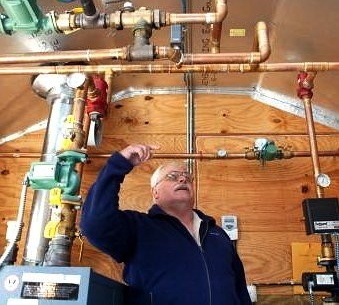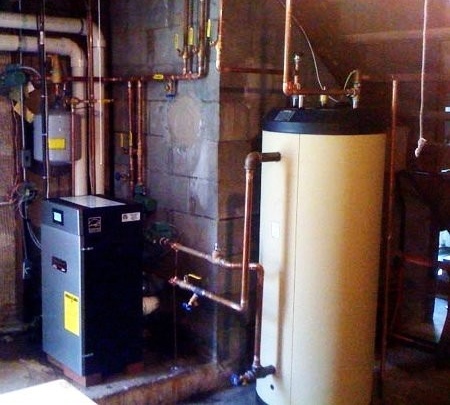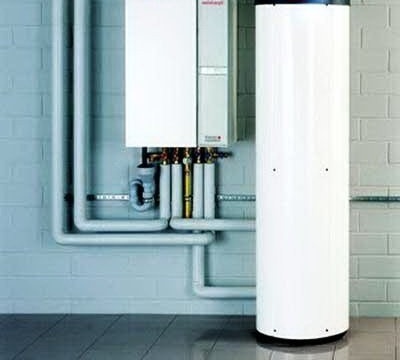Tying a heating boiler with polypropylene - the simplest schemes + a personal example
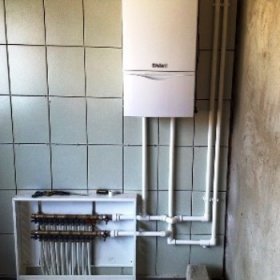
Pipes made of polypropylene using innovative technologies have many priorities, among which low cost and resistance to aggressive factors occupy leading positions. Affordable products serve the owners no less than expensive counterparts. On the walls they are not deposited reducing the diameter of the pipeline plaque. The connections are made by soldering, so that the piping of the boiler with polypropylene becomes "monolithic", that is, there will definitely not be any leaks in pipelines with poorly installed fittings. However, there are some nuances that homeowners who choose polypropylene for communications should be aware of.
Content
Polypropylene tying specifics
A significant advantage of polypropylene pipelines is the ability to create a circuit of any complexity, which, in principle, is not very interesting for those who heating boiler piping do it yourself for the first time. The simpler the scheme of the future system, the easier it will be to realize the idea. And heating performance is inversely proportional to the degree of complexity: the simpler, the more efficient. To make connections, the home master can use both welding technology and fittings selected strictly according to the size of the pipes. However, at the slightest “shifts” in the places where fittings are installed, the system may begin to leak slightly.
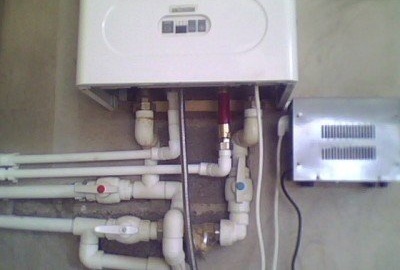
Using polypropylene pipes, it is possible to create heating circuits of any complexity, however, it should be remembered that complexity complicates installation and reduces the efficiency of the heating system
It is desirable that the created heating system has the least number of connections. If you can make a smooth transition, you need to use it.
The polypropylene pipeline will work without problems for 40 years, guaranteed by the manufacturer, it will withstand pressure above 25 bar. Without harming the structure of the material, a coolant with a temperature of 95º can circulate through the pipes. However, there is a limitation, which must be taken into account if the gas boiler is strapped.
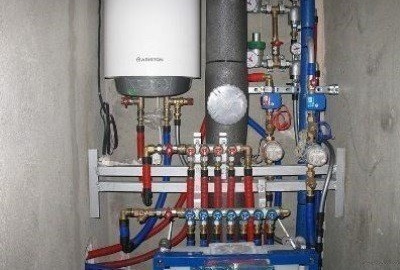
The gas connection to the boiler must be rigid, construction requirements dictate the use of metal elements for connection and the use of a paronite gasket
The gas supply to the boiler must have a rigid connection. Construction requirements recommended a metal pipe and docking with a heat generator through a metal drive or "American". You can only use a gasket made of paronite. Rubber materials, fum tapes, tow are prohibited.Paronite, obtained by vulcanizing a mixture of asbestos fibers, mineral fillers and rubber, keeps its shape perfectly, ensures tightness and does not burn. Other cushioning materials are prone to fire, and rubber sandwiched between the elements can reduce the size of the gas passage. By reducing the diameter of the passage, the gas supply will be reduced, and the boiler will not supply the required amount of heat.
Determining the location of the boiler in the overall system
The boiler is the main “organ” of the heating circuit, the choice of the strapping scheme to a large extent depends on its type. The outdoor heat generator cannot be located at the highest point in the piping layout. This is the main rule of its installation. In case of non-compliance with the specified conditions in the boiler that does not have a device for venting air, air jams will accumulate. The supply pipe coming out of the boiler without an air exhaust device must have a strictly vertical direction.
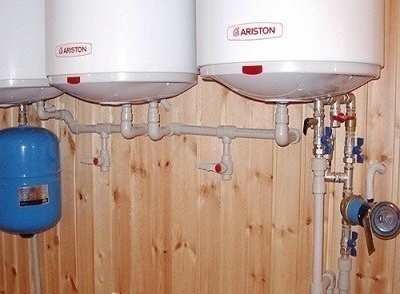
The presence of an automatic air vent mounted in an electric or gas boiler can be determined by the nozzles located at the bottom of the unit, they connect the supply line and return line
The pipes located at the bottom of the unit will tell you about the presence of an automatic air vent installed in the boiler, designed to be connected to the heating network. Typically, wall mounted electrical or gas equipment. This feature of the wall heating boiler strapping scheme must be taken into account, since most monoblock boilers mounted on the wall can independently be freed from accumulated air.
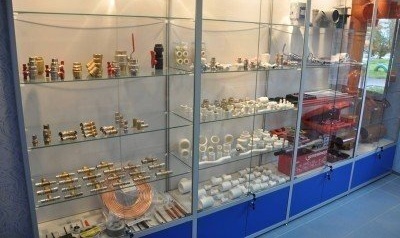
If the boiler was purchased without an expansion tank, pump, pressure control device, all the missing components can be purchased separately, a safety group can be installed both at the inlet and at the outlet of the coolant
Boilers can now be bought, as with an expansion tank, circulation pump and a security group, and without the entire list of additional devices. If the purchased unit does not have the listed devices, they can be purchased separately and included in the circuit. People building natural circulation system, for the most part, they are not needed, but those who arrange a circuit with forced heating will definitely need it.
Ways of tying heating boilers
According to the principle of circulation of the coolant along the heating circuit, all types of piping are divided into systems with natural and forced movement. In the last of these groups there are subgroups, the division into which is carried out according to the type of wiring.
Option # 1 - Natural Circulation Circuits
This group includes the simplest and most affordable systems for self-installation. A characteristic feature of this heating, also called gravitational, is the absence of a pump that stimulates the movement of the coolant. That is, the movement of heated water to the heating devices and the outflow of cold is performed on the basis of physical laws without human intervention and mechanisms. The simplest boiler piping scheme is suitable for small country houses. She will not cope with the maintenance of high-rise buildings and structures of a large area.

Tying a heating boiler with natural circulation is the best option for self-installation, it includes only a boiler, radiators and an expansion tank
Advantages of gravity heating:
- the easiest installation;
- work that does not depend on the availability of the power grid and interruptions associated with the supply of this energy carrier;
- budget size of both construction and maintenance;
- almost uninterrupted functionality, because in their composition there are no devices that can fail at the wrong time;
- the ability to repair the system yourself, unless, of course, the boiler needs to be repaired.
Cons too.Accurate calculations of the diameter of the pipes are necessary in order for the circuit to fully perform its functions. The diameter will be considerable, which far from always suits the owners of compact cottages. The interior looks like a system with natural circulation is not too presentable. It is impossible to regulate its functionality. However, the strapping scheme of the floor gas boiler or wall unit can be upgraded by inserting a circulation pump, which can be used if necessary.
About how to choose a suitable circulation pump, read in our material:https://aquatech.tomathouse.com/en/otoplenie/documents/cirkulyacionnyi-nasos-dlya-otopleniya.html.
Option # 2 - forced heating
Circuit with forced movement the coolant is more comfortable, the owner can control its work. It will be possible to choose the optimum temperature for each of the rooms, and the mode set by the owner will be automatically maintained. It is only necessary to take into account that such a strapping of the floor boiler and wall-mounted heat generator requires power. In case of interruptions, not uncommon for domestic networks, the circuit will not work. If electricity is not supplied, this type of heating will have to be abandoned.
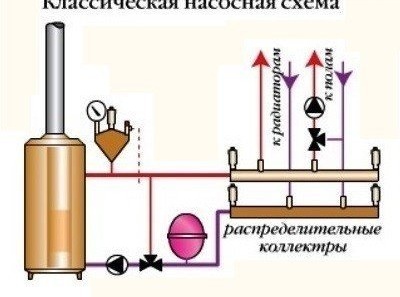
The classic version of the heating boiler strapping requires balancing and mandatory maintenance of devices
Minuses:
- a complex strapping scheme, including a mass of flow meters, air exhaust devices, distribution manifolds, valves, etc .;
- Mandatory device balancing
- the need for regular, expensive service;
- professional installation and repair that takes a lot of money;
- the high cost of instruments and services of installers.
The number of devices mounted in the network can be reduced by applying the principle of primary-secondary rings. Protection and control devices will be less, but each of the arranged heating rings will need to be equipped with its own circulation pump. Systems consisting of several rings with a floor-standing boiler with a capacity of less than 50 kW are equipped with comb-collectors, guaranteeing an even supply of coolant to the devices.

Using the principle of primary-secondary rings can significantly reduce the number of devices mounted in the heating circuit
The houses built for numerous families have heating with hydraulic equalizers. Hydraulic switches are introduced into heating circuits with powerful boilers with a capacity of over 50 kW, which supply heat not only to the main heating circuit, but also, for example, to the system “warm floors».
The hydraulic leveling device distributes heat evenly across all devices, eliminating pressure drops in different rings. Similar work in the circuits with primary-secondary rings only without pressure equalization is performed by manifold collectors.
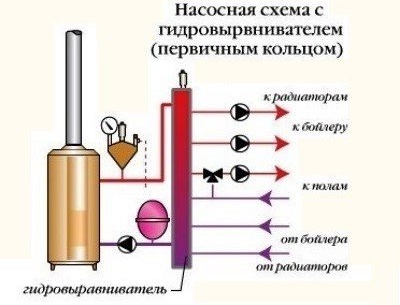
The boiler piping scheme with a hydraulic equalizer is used in the case of installing a unit with a capacity of 50 kW or more, as well as in the case of a large number of consumers
What type of heating system device the owner of the house will choose should depend not only on his desire, but first of all on the range of tasks for which a circuit is mounted:
- A small country house can easily be equipped with the simplest gravitational system on its own.
- Houses with water floors in several rooms, with individual hot water supply, will require complex schemes for connecting heating boilers with complex functional appliances.
Which strapping scheme to choose?
Here is a great selection of expert tips:
And in this video you can see a good example of collector wiring:
For solid fuel boilers, binding is required. Methods and schemes are presented in our next article:https://aquatech.tomathouse.com/en/otoplenie/kotly/podklyuchaem-tverdotoplivnyj-kotyol-k-sisteme-otopleniya-problemy-i-ix-reshenie.html.
Even if you do not intend to build the network yourself, it is recommended that the owners know the circuit diagrams of its structure in order to stop violations detected during installation and to fix minor problems on their own.
